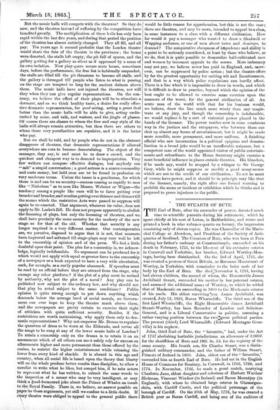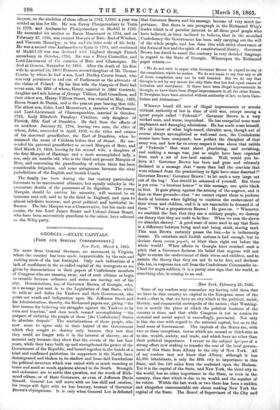THE STUARTS OF BUTE.
THE Earl of Bute, after his surrender of power, devoted much time to scientific pursuits during his retirement, which he spent chiefly at his seat of Luton, in Bedfordshire, and wrote and printed a book in nine volumes quarto on botany, the impression consisting only of eleven, copies. He was Chancellor of the Maris- chal College at Aberdeen, and President of the Society of Anti- quaries of Scotland. The Countess of Bute, who was born at Pera during her father's embassy at Constantinople, succeeded on his death in February, 1751, to the life-rent of his extensive estates in Cornwall and Yorkshire, her brother, Edward Wortley-Mon- tagu, having been diainherited. On the 3rd of April, 1761, she was created a peeress of Great Britain, as Baroness Diontstuart of Wortley, in Yorkshire, with remainder to the heirs male of her body by the Earl of Bute. She died:November 6, 1794, having had eleven children, the second of whom, the Honourable James Archibald Stuart, succeeded his mother in her paternal estates, and assumed the additional name of Wortley, to which he added that of Mackenzie on sacceedi g in 1800 to the Mackenzie estates of his uncle. His eldest surviving sou. James Archibald, was created; July 12, 1826, Baron Wharncliffe. The third son of the first Lord Wharncliffe, the Right Honourable James Archibald Stuart-Wortley, has been Recorder of London and Solicitor- General, and is a Liberal Conservative in politics, assuming a rather varying position between the two:great political parties. The present (third) Lord Wharncliffe (Edward Montague Gran- ville) is his nephew.
John, third Earl of Bute, the "favourite," had, under the Act of 1747 abolishing heritable jurisdictions, an allowance of 2,000/. for the sheriffdom of Bute and 186/. 9s. 3d. for the registry of the same county. His fourth son, Sir Charles Stuart, was a distin- guished military commander, and the father of William Stuart, Primate of Ireland in 1800. John, eldest son of the "favourite," succeeded him as fourth Earl of Bute. He had sat in the English House of Commons for Bossiney, in Cornwall, in 1766, 1768, and 1774. In November, 1766, he made a great match, marrying Charlotte Jane, eldest daughter and coheiress of Herbert Wardsor Hickman, Viscount Windsor (in Ireland) and Baron Mountjoy (in England), with whom he obtained large estates in Glamorgan- shire, with Cardiff Castle, and the political patronage of the borough of Cardiff. On the 20th of May, 1776, he was created a British peer as Baron Cardiff, and being one of the auditors of inquest, on the abolition of these offices in 1782, 7,0001. a year was settled on him for life. He was Envoy Plenipotentiary to Turin in 1779, and Ambassador Plenipotentiary to Madrid in 1783. He succeeded his mother as Baron Montstuart in 1794, and on February 27, 1796, was created Marquis of Bute, Earl of Windsor, and Viscount Mountjoy, to him and the heirs male of his body. He was a second time Ambassador to Spain in 1795, and continued at Madrid till war was declared with England through French ascendency in October, 1796. He was a Privy Councillor, and Lord-Lieutenant of the counties of Bute and Glamorgan. He died at Geneva, November 16, 1814. After the death of his that wife he married (in 1800) Frances, second daughter of Mr. Thomas Coats, by whom he had a son, Lord Dudley-Coutts Stuart, who was very prominent in and out of Parliament as the advocate of the claims of Poland. By his first wife the Marquis of Bute had seven sons, the fifth of whom, Henry, married in 1802 Gertrude, daughter and sole heiress of .George Villiers, Earl Grandison, and their eldest son, Henry-Villiers Stuart, was created in May, 1839, Baron Stuart de Decies, and is the present peer bearing that title. The eldest son, John, Lori Montstuart, a member of Parliament and Lord-Lieutenant of Glamorganshire, married in October, 1792, Lady Elizabeth Penelope Crichton, only daughter Of Patrick, fifth Earl of Dumfries. He died from the effects of an accident January 22, 1794, leaving two sons, the elder of whom, John, succeeded in April, 1803, to the titles and estates of his maternal grandfather, the Earl of Dumfries, when he assumed the name of Crichton before that of Stuart. He suc- ceeded his paternal grandfather as second Marquis of Bute, and died March 18, 1848, leaving by his second wife, a daughter of the first Marquis of Hastings, and a most accomplished lady, a son, only six months old, who is the third and present Marquis of Bute, and concerning the guardianship of whom there has been considerable litigation, and some antagonism between the rival jurisdictions of the English and Scotch Courts.
The family has been during the last century particularly fortunate in its matrimonial alliances, but equally unlucky in the premature deaths of the possessors of its dignities. The young Marquis, should he survive his minority, will succeed to an immense rent-roll, said to be the third in England, and open to almost indefinite increase, and great political and territorial in- fluence. The late Marquis was a Conservative, but his uncle and cousin, the late Lord James Stuart and Colonel James Stuart, who have been successively guardians to the minor, have adhered to the Whig party.































 Previous page
Previous page